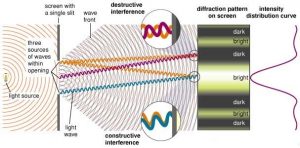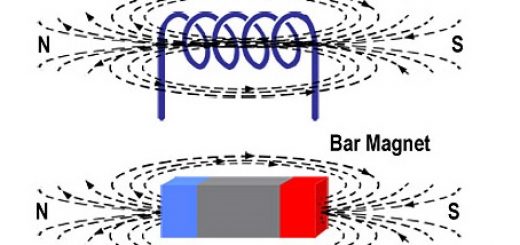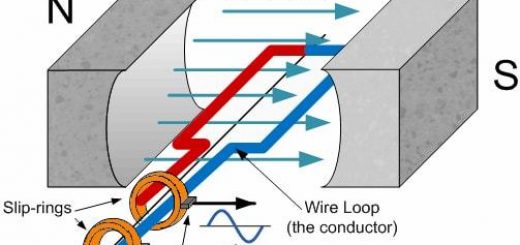Properties of light interference and light diffraction
Light waves properties
Light waves propagate in straight lines in the homogeneous medium , They reflect when they fall on a reflecting surface , They refract when they travel between two transparent media different in the optical density , according to the laws of refraction .
The light waves interfere when they have the same frequency , amplitude and phase producing regions of constructive interference and regions of destructive interference , They diffract in the same medium when they pass through a slit or by a sharp edge having dimensions near to the wavelength of the light waves .
Light interference
You can get a source of a monochromatic light to explain the light interference phenomenon , So , the wavelength has one constant value , Screen with a rectangular slit ( S ) at an appropriate distance from the light source , Screen with two narrow slits ( S1 and S2 )and screen to receive the waves .
On operating the light source , the light waves pass from the slit ( S ) in form of cylindrical waves , The double slits screen at the wave front , So , the produced waves from the double slits have the same phase ( coherent ) , The double slits screen acts as a source of two coherent waves .
The two waves propagates and when they reach the last screen they give :
Bright regions ( bright fringes ) when a crest from ( S1 ) meets a crests from ( S2 ) or a trough from ( S1 ) meets a trough from ( S2 ) , where the path difference between the two interfered waves is 0 , λ , 2λ , ……..or mλ , This is called constructive interference .
Dark regions ( dark fringes ) when a crest from ( S1 ) meets a trough from ( S2 ) or a trough from ( S1 ) meets a crest from ( S2 ) , where the path difference between the two interfered waves is ½ λ , 3 ⁄2λ , 5 ⁄2λ , …….. or ( m + ½ ) λ , This is called destructive interference .
Wave front is the surface which all its points have the same phase and this surface is perpendicular to the direction of wave propagation , The coherent light sources are the sources that produce waves of the same frequency , amplitude and the same phase .
The distance between two successive fringes of the same kind ( bright or dark ) can be determined from the relation : Δy = λ R / d , where ( λ ) is the wavelength of the used light , ( R ) is the distance between the double slits screen and the observation screen and ( d ) is the distance between the two slits .
Conditions of interference
- Each of the two light sources must be monochromatic .
- The two light sources must be coherent have the same frequency , amplitude and phase
The interference has two types which are constructive interference and destructive interference .
Constructive interference is interference that produces reinforcement in the intensity of the light in some regions ( bright fringes ) as a result of meaning a crest of one wave with a crest of another wave or a trough of one wave with a trough of another wave .
Condition : The path difference of the two interfered waves equals ( mλ ) , where ( m = 0 , 1 , 2 , …….or any integer ) .
Destructive interference is interference that produces weakness in the intensity of the light in some regions ( dark fringes ) as a result of meeting a crest of one wave with a trough of another wave .
Condition : The path difference of the two interfered waves equals ( m + ½ ) λ , where ( m = 0, 1 , 2 , ….. or any integer ) .
Light interference is a phenomenon of superposition of light waves produced from two coherent sources and produces reinforcement of light in some regions ( bright fringes ) and weakness in other regions ( dark fringes ) , Interference fringes is a sequence of bright and dark straight parallel regions .
Factors affect the distance between two successive fringes of the same kind
- The wavelength of the used light ( λ ) ( directly proportional ) .
- The distance between the observation screen and the double slits screen ( R ) ( directly proportional ) .
- The distance between the two slits ( d ) ( Inversely proportional ) .
Light diffraction
When monochromatic light waves fall on a circular aperture on a screen , They change their direction of propagation ( diffract ) , They combine with ( superpose ) each other behind the aperture , Rings of bright and dark fringes appear on the observation screen and the central bright spot is called airy’s disk .
Light diffraction is a phenomenon of changing the direction of light waves when they pass through a small aperture leading to the superposition of light waves and formation of bright and dark fringes .
Airy’s disk is a bright circular spot formed on the observation screen when monochromatic light waves diffract through a circular aperture .
Conditions of appropriate light diffraction :
The wavelength of the light wave is comparable to the dimensions of the aperture and vice versa , From our study to the interference and diffraction phenomena , there is no big difference between them but each of them is a wave phenomenon which originates from superposition of the waves .
Types & Laws of light reflection, Regular & Irregular reflection of light
Applications on the total reflection of light ( Optical fibers , Reflecting prism & Mirage )
Light waves properties, Analysis of white light, Spectrum colours & Light intensity
Light refraction effects, Law of light refraction, Mirage & Apparent positions of objects




